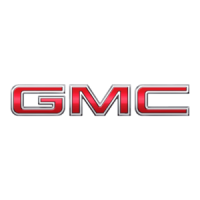
Do you have a question about the GMC Savana 2020 and is the answer not in the manual?
| Brand | GMC |
|---|---|
| Model | Savana 2020 |
| Category | Automobile |
| Language | English |
Guide on how to effectively use the owner's manual for quick reference.
Explanation of hazard symbols indicating danger, warning, and caution levels.
Overview of the instrument panel layout and controls.
Information on keys, remote keyless entry, and door lock systems.
Details on the vehicle's anti-theft alarm system and immobilizer.
Information on convex mirrors and their adjustment for visibility.
Instructions for adjusting the rearview mirror for optimal visibility.
Operation and safety precautions for power windows.
Information on head restraint adjustment and function.
Details on front seat adjustment, including power seats and reclining.
Comprehensive guide on seat belt usage, types, and safety.
Information on the vehicle's airbag system, types, and operation.
Guidelines for using child restraints, including types and placement.
Proper use and safety of rear-facing infant restraints.
Proper use and safety of forward-facing child restraints.
Guidelines for using booster seats for older children.
Instructions for using the LATCH system for child restraint installation.
Information on locating and using vehicle storage compartments.
Details on extra storage features like cargo tie-downs.
Overview of vehicle controls, including steering wheel and dashboard.
Explanation of dashboard warning lights, gauges, and indicators.
Detailed diagram and explanation of the instrument cluster displays.
Information on the fuel gauge operation and potential readings.
Explanation of the seat belt reminder system and light.
Information on the airbag readiness light and system checks.
Instructions for manually turning the front passenger airbag on or off.
Explanation of the check engine light and potential causes.
Information on the brake system warning light and potential issues.
Explanation of the ABS warning light and when to seek service.
Information on the lane departure warning light and its indicators.
Explanation of the StabiliTrak OFF indicator and its function.
Information on the TCS and StabiliTrak system indicator lights.
Explanation of the tire pressure warning light and TPMS.
Information on the engine oil pressure warning light.
Explanation of the security light and theft-deterrent system.
Information on the cruise control indicator light.
Overview of the Driver Information Center and its displays.
How to operate and interpret the DIC display.
Explanation of the functions of the DIC buttons.
Details on trip and fuel menu items available on the DIC.
Information on engine oil life monitoring and maintenance.
Explanation of the Side Blind Zone Alert system.
Information on the Park Assist system and its operation.
Explanation of engine power reduction messages.
Guide to customizing vehicle features and settings.
Controls and features for exterior lighting systems.
Operation of exterior lamp controls, including AUTO and manual modes.
How the automatic headlamp system works and its features.
Operation of hazard warning flashers for emergencies.
How to use turn and lane-change signals.
Adjusting the brightness of the instrument panel and radio display.
Operation of interior dome lamps and override features.
Details on entry, exit, and battery saving lighting features.
Explanation of the battery load management system.
Introduction to the vehicle's infotainment system.
Information on operating the AM-FM radio, finding stations, and favorites.
How to operate the radio, CD, and MP3 player.
Factors affecting radio reception and how to improve it.
Precautions when using external media devices with the system.
Information on operating and caring for the CD player.
How to connect and use external audio devices via the auxiliary input jack.
How to connect and control USB devices with the infotainment system.
Introduction to the OnStar system and its capabilities.
Details on OnStar Emergency Services and Automatic Crash Response.
Information on OnStar security services like Stolen Vehicle Assistance.
How GPS signals work with OnStar and potential obstructions.
Overview of connected services available for the vehicle.
Information on using the vehicle's navigation system.
Services related to staying connected, including Wi-Fi hotspot.
Explanation of OnStar Advanced Diagnostics for vehicle maintenance.
Control of heating, cooling, and ventilation systems.
Instructions for using and directing air vents.
Information on servicing the climate control system.
Operation of climate controls for vehicles equipped with AC.
How to use the rear window defogger.
Adjusting the amount of air flow for the rear heating system.
Controls for rear climate settings, temperature, fan speed, and air delivery.
Tips for better fuel economy, defensive driving, and handling distractions.
Procedures for new vehicle break-in and starting the engine.
Information on automatic transmission operation and range selection.
Details on the Antilock Brake System (ABS) and braking in emergencies.
Explanation of TCS and StabiliTrak/ESC system operation.
How to use cruise control, including setting and reducing speed.
Overview of systems designed to help avoid crashes.
How the FCA system helps avoid or reduce harm from front-end crashes.
Explanation of the SBZA system for lane-changing assistance.
Information on the LDW system and how it helps avoid crashes.
Recommendation for using TOP TIER Detergent Gasoline.
Guidance on the recommended fuel types for the vehicle.
List of fuels that should not be used in the vehicle.
Information on using E85 or FlexFuel and its requirements.
Instructions and safety precautions for refueling the vehicle.
Overview of towing requirements and safety tips.
How trailering affects vehicle handling, acceleration, and braking.
Importance of understanding trailer weight and its impact.
Explanation of GCWR and how to calculate vehicle and trailer weight.
Information on vehicle's maximum load capacity.
Calculation of maximum trailer weight based on vehicle configuration.
Table detailing towing capacities for different vehicle models and configurations.
Information on selecting and using the correct hitch equipment.
Guidance on adjusting weight-distributing hitches for trailer stability.
General information about tires, including maintenance and safety.
Explanation of information found on tire sidewalls.
Definitions of common tire terms and concepts.
Importance of correct tire pressure and consequences of improper inflation.
How the TPMS works to monitor and warn about tire pressure.
Recommendations for inspecting tires for wear and damage.
Guidelines for rotating tires to ensure uniform wear.
Factors affecting tire wear and when to replace tires.
Proper procedures for storing a vehicle for extended periods.
Recommendations for selecting and purchasing new tires.
Importance of wheel alignment and tire balance for tire longevity.
When and how to replace wheels and associated components.
Information on using tire chains, including clearance and installation.
What to do if a tire blows out or loses air while driving.
Step-by-step guide for changing a tire.
Instructions for accessing and removing the spare tire and tools.
Proper storage of spare tires and tools to prevent injury or damage.
Safe procedures for jump starting a vehicle's battery.
Cautionary information and procedures for towing a disabled vehicle.
Considerations for towing the vehicle behind another vehicle.
Procedures for cleaning and maintaining the vehicle's exterior finish.
Lubrication and care instructions for vehicle locks.
Guidelines for washing the vehicle to preserve its finish.
How to clean exterior lamps, lenses, emblems, decals, and stripes.
Instructions for cleaning windshields and wiper blades.
Guidelines for cleaning tires using a stiff brush and tire cleaner.
How to clean wheels and wheel trim using mild soap and water.
Visual inspection of brake lines, hoses, pads, and rotors.
Visual inspection of steering, suspension, and chassis components.
Guidelines for proper floor mat usage and installation.
Overview of the maintenance section and owner responsibilities.
Schedule of required maintenance services for the vehicle.
Services for specific vehicle applications like dual wheels or commercial use.
Services and conditions that may require attention.
List of recommended fluids and lubricants for the vehicle.
Part numbers for recommended replacement parts.
Log for recording scheduled services and maintenance performed.
Information on Vehicle Identification Number (VIN) and engine identification.
Information on how to identify service parts using barcodes.
Details on vehicle capacities and specifications.
Table of approximate fluid capacities and technical specifications.
Diagrams showing engine drive belt routing for different engine types.
Steps to resolve concerns with dealerships and GM.
Contact information for customer assistance in the US and Canada.
Contact options for customers using Text Telephone (TTY) devices.
Accessing owner resources and vehicle health information online.
Information on the program for eligible adaptive equipment reimbursement.
Details on roadside assistance coverage and services provided.
Information needed when calling for roadside assistance.
How to schedule warranty service appointments with your dealer.
Overview of the courtesy transportation program for owners.
Importance of using qualified technicians and proper replacement parts.
Information on Genuine GM Collision parts vs. recycled parts.
Recommendations for choosing a collision repair facility.
Advice on vehicle insurance coverage and using OEM parts.
Steps to take in case of a crash, including emergency services.
Information on how to order service manuals and customer literature.
Statement regarding radio frequency operation and compliance.
How to report vehicle safety defects to NHTSA.
Information on vehicle data collection, privacy, and cybersecurity.
GM's commitment to protecting vehicle electronics and customer data.
Explanation of the vehicle's event data recorder (EDR).
Introduction to the OnStar system and its services.
Overview of connected services, including Navigation, Connections, Diagnostics.
Instructions for using the vehicle's navigation system.
Services related to staying connected, including Wi-Fi hotspot.
Explanation of OnStar Advanced Diagnostics for vehicle maintenance.
Accessing vehicle services via the myGMC mobile app.
Control of heating, cooling, and ventilation systems.
Instructions for using and directing air vents.
Information on servicing the climate control system.
Operation of climate controls for vehicles equipped with AC.
How to use the rear window defogger.
Adjusting the amount of air flow for the rear heating system.
Controls for rear climate settings, temperature, fan speed, and air delivery.
Tips for better fuel economy, defensive driving, and handling distractions.
Procedures for new vehicle break-in and starting the engine.
Information on automatic transmission operation and range selection.
Details on the Antilock Brake System (ABS) and braking in emergencies.
Explanation of TCS and StabiliTrak/ESC system operation.
How to use cruise control, including setting and reducing speed.
Overview of systems designed to help avoid crashes.
How the FCA system helps avoid or reduce harm from front-end crashes.
Explanation of the SBZA system for lane-changing assistance.
Information on the LDW system and how it helps avoid crashes.
Recommendation for using TOP TIER Detergent Gasoline.
Guidance on the recommended fuel types for the vehicle.
List of fuels that should not be used in the vehicle.
Information on using E85 or FlexFuel and its requirements.
Instructions and safety precautions for refueling the vehicle.
Overview of towing requirements and safety tips.
How trailering affects vehicle handling, acceleration, and braking.
Importance of understanding trailer weight and its impact.
Explanation of GCWR and how to calculate vehicle and trailer weight.
Information on vehicle's maximum load capacity.
Calculation of maximum trailer weight based on vehicle configuration.
Table detailing towing capacities for different vehicle models and configurations.
Information on selecting and using the correct hitch equipment.
Guidance on adjusting weight-distributing hitches for trailer stability.
General information about tires, including maintenance and safety.
Explanation of information found on tire sidewalls.
Definitions of common tire terms and concepts.
Importance of correct tire pressure and consequences of improper inflation.
How the TPMS works to monitor and warn about tire pressure.
Recommendations for inspecting tires for wear and damage.
Guidelines for rotating tires to ensure uniform wear.
Factors affecting tire wear and when to replace tires.
Proper procedures for storing a vehicle for extended periods.
Recommendations for selecting and purchasing new tires.
Importance of wheel alignment and tire balance for tire longevity.
When and how to replace wheels and associated components.
Information on using tire chains, including clearance and installation.
What to do if a tire blows out or loses air while driving.
Step-by-step guide for changing a tire.
Instructions for accessing and removing the spare tire and tools.
Safe procedures for jump starting a vehicle's battery.
Cautionary information and procedures for towing a disabled vehicle.
Considerations for towing the vehicle behind another vehicle.
Procedures for cleaning and maintaining the vehicle's exterior finish.
Lubrication and care instructions for vehicle locks.
Guidelines for washing the vehicle to preserve its finish.
Instructions for cleaning windshields and wiper blades.
Guidelines for cleaning tires using a stiff brush and tire cleaner.
How to clean wheels and wheel trim using mild soap and water.
Visual inspection of brake lines, hoses, pads, and rotors.
Visual inspection of steering, suspension, and chassis components.
Guidelines for proper floor mat usage and installation.
Overview of the maintenance section and owner responsibilities.
Schedule of required maintenance services for the vehicle.
Services for specific vehicle applications like dual wheels or commercial use.
Services and conditions that may require attention.
List of recommended fluids and lubricants for the vehicle.
Part numbers for recommended replacement parts.
Log for recording scheduled services and maintenance performed.
Information on Vehicle Identification Number (VIN) and engine identification.
Information on how to identify service parts using barcodes.
Details on vehicle capacities and specifications.
Table of approximate fluid capacities and technical specifications.
Diagrams showing engine drive belt routing for different engine types.
Steps to resolve concerns with dealerships and GM.
Contact information for customer assistance in the US and Canada.
Contact options for customers using Text Telephone (TTY) devices.
Accessing owner resources and vehicle health information online.
Information on the program for eligible adaptive equipment reimbursement.
Details on roadside assistance coverage and services provided.
Information needed when calling for roadside assistance.
How to schedule warranty service appointments with your dealer.
Overview of the courtesy transportation program for owners.
Importance of using qualified technicians and proper replacement parts.
Information on Genuine GM Collision parts vs. recycled parts.
Recommendations for choosing a collision repair facility.
Advice on vehicle insurance coverage and using OEM parts.
Steps to take in case of a crash, including emergency services.
Information on how to order service manuals and customer literature.
Statement regarding radio frequency operation and compliance.
How to report vehicle safety defects to NHTSA.
Information on vehicle data collection, privacy, and cybersecurity.
GM's commitment to protecting vehicle electronics and customer data.
Explanation of the vehicle's event data recorder (EDR).
Introduction to the OnStar system and its services.
Overview of connected services, including Navigation, Connections, Diagnostics.
Instructions for using the vehicle's navigation system.
Services related to staying connected, including Wi-Fi hotspot.
Explanation of OnStar Advanced Diagnostics for vehicle maintenance.
Accessing vehicle services via the myGMC mobile app.











